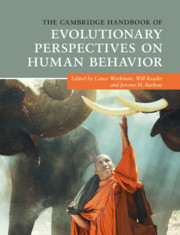Book contents
- The Cambridge Handbook of Evolutionary Perspectives on Human Behavior
- The Cambridge Handbook of Evolutionary Perspectives on Human Behavior
- Copyright page
- Dedication
- Contents
- Figures
- Tables
- Contributors
- Preface
- Acknowledgments
- Part I The Comparative Approach
- Part II Sociocultural Anthropology and Evolution
- Part III Evolution and Neuroscience
- Part IV Group Living
- Part V Evolution and Cognition
- 17 Runaway Processes in Modern Human Culture
- 18 Ontogeny of Tactical Deception
- 19 The Evolution of Language
- 20 The Adaptive Problem of Exploiting Resources
- Part VI Evolution and Development
- Part VII Sexual Selection and Human Sex Differences
- Part VIII Abnormal Behavior and Evolutionary Psychopathology
- Part IX Applying Evolutionary Principles
- Part X Evolution and the Media
- Index
- References
17 - Runaway Processes in Modern Human Culture
An Evolutionary Approach to Exaggerated Communication in Present Human Societies
from Part V - Evolution and Cognition
Published online by Cambridge University Press: 02 March 2020
- The Cambridge Handbook of Evolutionary Perspectives on Human Behavior
- The Cambridge Handbook of Evolutionary Perspectives on Human Behavior
- Copyright page
- Dedication
- Contents
- Figures
- Tables
- Contributors
- Preface
- Acknowledgments
- Part I The Comparative Approach
- Part II Sociocultural Anthropology and Evolution
- Part III Evolution and Neuroscience
- Part IV Group Living
- Part V Evolution and Cognition
- 17 Runaway Processes in Modern Human Culture
- 18 Ontogeny of Tactical Deception
- 19 The Evolution of Language
- 20 The Adaptive Problem of Exploiting Resources
- Part VI Evolution and Development
- Part VII Sexual Selection and Human Sex Differences
- Part VIII Abnormal Behavior and Evolutionary Psychopathology
- Part IX Applying Evolutionary Principles
- Part X Evolution and the Media
- Index
- References
Summary
In biology, runaway selection has been proposed as an evolutionary mechanism to explain the emergence of exaggerated morphological and behavior features in animals. Such runaway processes usually manifest if there is a fundamental change in the constraints that control the emergence of a specific trait. Here, we argue that the exaggerated communication in modern humans is the expression of a biological feature that has been liberated from environmental control. Social evolution of humans has led to increased group size, which, in turn, selected for a biologically supported need for communication in order to continuously keep contact with an increasing number of group members. This selection process led eventually to the emergence of language a few tens of thousands of years ago. However, up to a few hundred years ago, spoken communication was limited by spatial and temporal constraints.
- Type
- Chapter
- Information
- Publisher: Cambridge University PressPrint publication year: 2020



